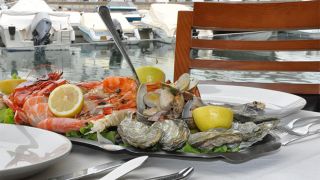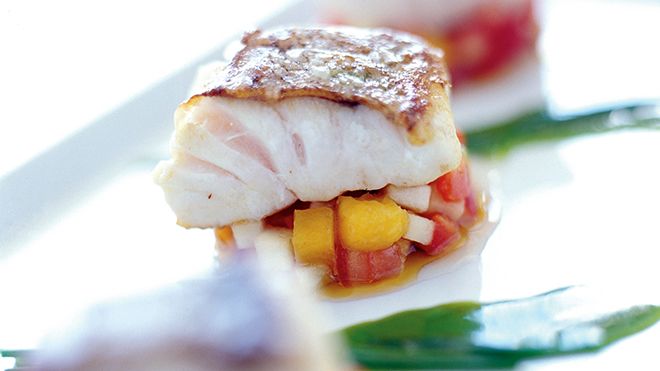The very freshest fish and seafood come from the sea, and are the main ingredients in the Algarve cuisine. They are joined by vegetables and fruits whose flavours the sun has made sublime, and their combination provide the elements for a dining experience that you will never forget.
Start with what the ocean provides. Seafood: clams, oysters, donax clams and cockles cooked on a griddle or in a frying pan are delicious. Some plain barnacles on a beach on the Vicentina coast, razor clam rice, whelk bean stew, clam xerém (stew with maize meal) and seafood açorda (bread casserole) are other examples to make the mouth water. One much sought-after recipe is for clams in a cataplana, a traditional dish whose secret is in using this clam-shaped copper pan of Arab origin, which retains all the flavour and aroma of the food cooked in it. To stimulate the palate, there’s nothing better than a pinch of salt from the region, especially the "cream" of the salt – salt flower. In addition to the many restaurants where you can taste these specialties in the summer, there are seafood festivals in Olhão and Faro, near Ria Formosa, where it is most abundant.
But any fresh fish, slowly grilled to perfection over charcoal, the way the fishermen do it, can be a veritable food of the gods. There are other dishes such as carapaus alimados (skinned horse mackerel) and grilled sardines that you can eat everywhere but which have a special reputation in Portimão. They’re delicious dripping on bread or accompanied with a montanheira salad, made with tomato and oregano to add that special taste. From tuna steak or on a skewer in Tavira, to octopus, which in Santa Luzia is cooked in various ways - stewed in wine, breaded, grilled, with rice or simply baked in the oven – as well as the delicious squid and cuttlefish, the Algarve is the expert in these menus.
The very freshest fish and seafood come from the sea, and are the main ingredients in the Algarve cuisine. They are joined by vegetables and fruits whose flavours the sun has made sublime, and their combination provide the elements for a dining experience that you will never forget.
Start with what the ocean provides. Seafood: clams, oysters, donax clams and cockles cooked on a griddle or in a frying pan are delicious. Some plain barnacles on a beach on the Vicentina coast, razor clam rice, whelk bean stew, clam xerém (stew with maize meal) and seafood açorda (bread casserole) are other examples to make the mouth water. One much sought-after recipe is for clams in a cataplana, a traditional dish whose secret is in using this clam-shaped copper pan of Arab origin, which retains all the flavour and aroma of the food cooked in it. To stimulate the palate, there’s nothing better than a pinch of salt from the region, especially the "cream" of the salt – salt flower. In addition to the many restaurants where you can taste these specialties in the summer, there are seafood festivals in Olhão and Faro, near Ria Formosa, where it is most abundant.
But any fresh fish, slowly grilled to perfection over charcoal, the way the fishermen do it, can be a veritable food of the gods. There are other dishes such as carapaus alimados (skinned horse mackerel) and grilled sardines that you can eat everywhere but which have a special reputation in Portimão. They’re delicious dripping on bread or accompanied with a montanheira salad, made with tomato and oregano to add that special taste. From tuna steak or on a skewer in Tavira, to octopus, which in Santa Luzia is cooked in various ways - stewed in wine, breaded, grilled, with rice or simply baked in the oven – as well as the delicious squid and cuttlefish, the Algarve is the expert in these menus.
In the barrocal, the transition zone between the mountains and the coast, the cuisine is different, with meat being more predominant, like galinha cerejada (braised chicken), cozido de grão (boiled meats and chickpeas), and the sausages that in São Brás de Alportel and Querença have fairs and festivals in their honour. Here agriculture is one of the main activities, and the trees, whose fruit is indispensable in the manufacture of liqueurs and traditional sweets, add a unique beauty to the fields when they are in blossom, the almond tree in February being one of the emblematic images of the Algarve.
While oranges are eaten by themselves or drunk as juice, almonds, figs and carob are used in the much sought-after sweets. Like the dom rodrigos (egg and almond sweets) wrapped in colourful tinfoil, the morgados (small cakes made with sugar, almond, eggs, angel hair and pumpkin), usually decorated with regional motifs and almond blossom, and marzipan, the hard almond paste cakes in the most varied fruit and vegetable shapes. There are other specialties not to be missed, too, such as stuffed figs, cheeses and fig truffles. Medronho or fig brandy and bitter almond liqueur are excellent digestives at the end of a good meal.
In fact the best of the Algarve is served at the table. Whether on a simple beach terrace or in the finest restaurants led by world-renowned Chefs, it’s an experience not to be missed, and to be repeated many times!











 Explore
Explore 
 Remember and Share
Remember and Share 


